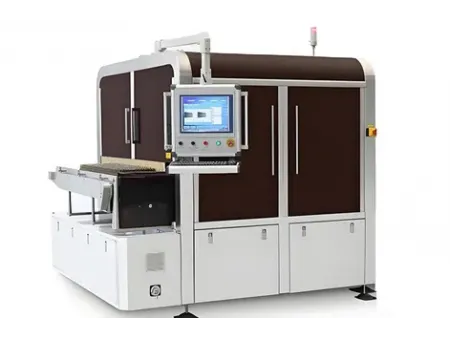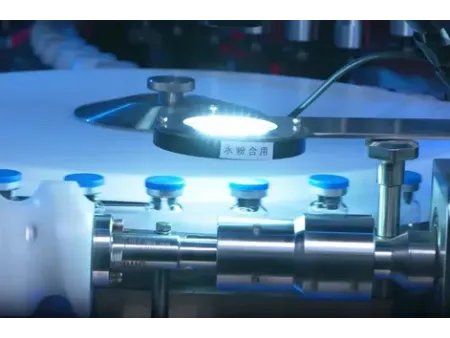- Stable operating speed of 200–600 pcs/min, with a detection precision of ≥50μm
- Validated using the Knapp test method, compliant with FDA and EU GMP standards
- Built with a full-servo drive system and a user-friendly HMI interface for seamless operation and auditracking
- Integrated with top-tier components: Basler cameras (Germany), Mitsubishi PLC & servo motors
- Powered by vision-based inspection algorithms for high detection accuracy
JAZ Automatic Visual Inspection (AVI)
- Speed: 200-600×(1±5%)pcs/min
- Applicable container: 1-20ml ampoules and vials
- Total power: 5.9kW
- Voltage: 380V, 50Hz
- Particle size: ≥50μm
- Worktable height: 900mm
- Machine dimensions (L×W×H): 2740×1900×2000mm
- Machine weight: approx. 2600kg
The automatic ampoule/vial inspection machine is primarily used in pharmaceutical manufacturing to inspect ampoule-based injectable products. It performs fully automated detection of visible foreign particles and cosmetic container defects to ensure product quality and safety.
Typical inspection items include:- Foreign particles: glass shards, fibers, hair, white specks, white powder
- Appearance defects: abnormal liquid levels, scorched necks, carbon spots, convex heads, concave heads, and bubble formations
This system helps you maintain high standards of sterility, clarity, and packaging integrity in compliance with international pharmaceutical regulations.
- Glass
- Reflected filber
- Glass
- Large glass
- Seismic-resistant construction improves overall machine stability during high-speed operation
- External electrical cabinet layout enhances resistance to electromagnetic interference and simplifies maintenance
- High-quality transmission bearings from SKF (Sweden) and NSK (Japan) ensure precision and durability
- Fixed-position braking at each bottle rotation station enhances performance and simplifies service tasks
- Integral lifting turntable design allows fast and easy changeover between different container sizes
- Incorporates 30 patented technologies, reflecting our deep innovation in visual inspection
- Complies with both European Pharmacopoeia and FDA Knapp testing standards, ensuring inspection accuracy and global regulatory alignment
- Fully servo-driven system enables precise, stable motion control across all stages of operation
The automatic ampoule/vial inspection machine follows a fully automated sequence designed for accuracy, consistency, and efficiency in pharmaceutical inspection.
- Products to be inspected
- Infeed bottles
- Bottle pressing
- Rotate bottles
- Stop
- Take pictures
- Photoelectric inspection area
- Image processing software system analysis
- Bottle outfeed
- Qualified bottles and the rejects collection
This smooth process ensures each container is reliably inspected and sorted without compromising speed or precision.
Built for precision and reliability, the automatic ampoule/vial inspection machine integrates mechanical handling, automated control, and advanced vision technology to ensure seamless inspection and smooth production.
Mechanical system- Rack
- Bottle-infeed conveying devices
- Bottle-infeed wheel
- Rotary tray
- Bottle-pressing device
- Rotary apparatus
- Cam lift
- Quick-change size parts device
- Outfeed wheel
- Qualified products/rejects collection plate
- Driving system
- Servo system
- Computer software processing system
- Central control unit
- Inspection camera
- Lighting device
- Light harrier
- Light source servo tracking device
- Image processing system
This configuration supports high-speed, accurate, and stable visual inspection while keeping maintenance simple and efficient.
Why is automated inspection important in the pharmaceutical industry?
Automated inspection plays a critical role in reducing contamination risks and improving batch release efficiency. Systems like the automatic ampoule/vial inspection machine deliver consistent, high-volume inspection results at high speed, minimizing human error and false rejections. Most importantly, they help you meet the strict standards set by global regulators such as the FDA and EMA, ensuring product sterility and container integrity.
How does visual inspection differ from high-voltage leak detection (HVLD)?
Visual inspection is designed to detect visible foreign particles, such as glass shards, fibers, hair, white specks and identify appearance defects like abnormal liquid levels, scorched or carbonized necks, and irregular finishes (e.g., convex, concave, or bubble heads).
In contrast, HVLD technology focuses on detecting leaks in containers like ampoules, vials, and oral liquid bottles. It identifies microcracks, pinholes, and seal integrity issues in areas like the container wall, neck, or base.
Interested in learning more about our Visual Inspection and Leak Testing Equipment
Get in touch with us today!



